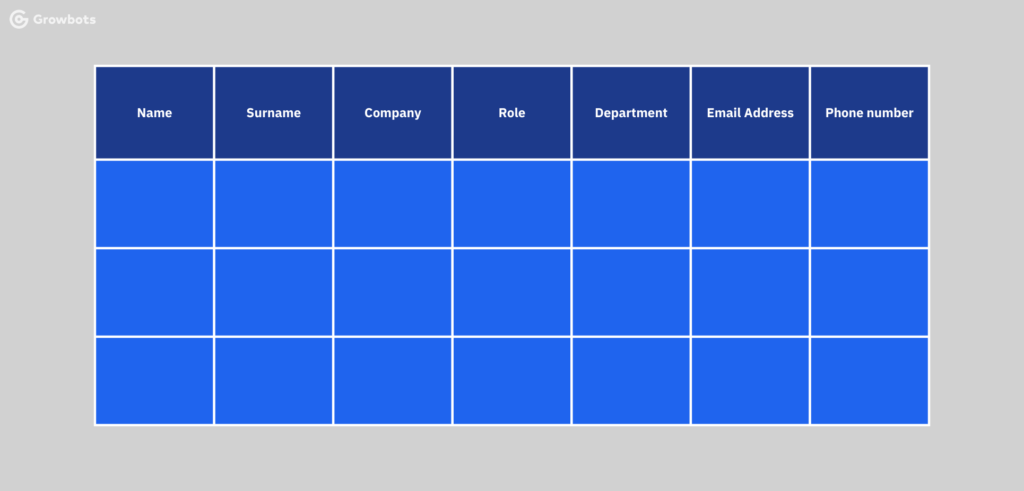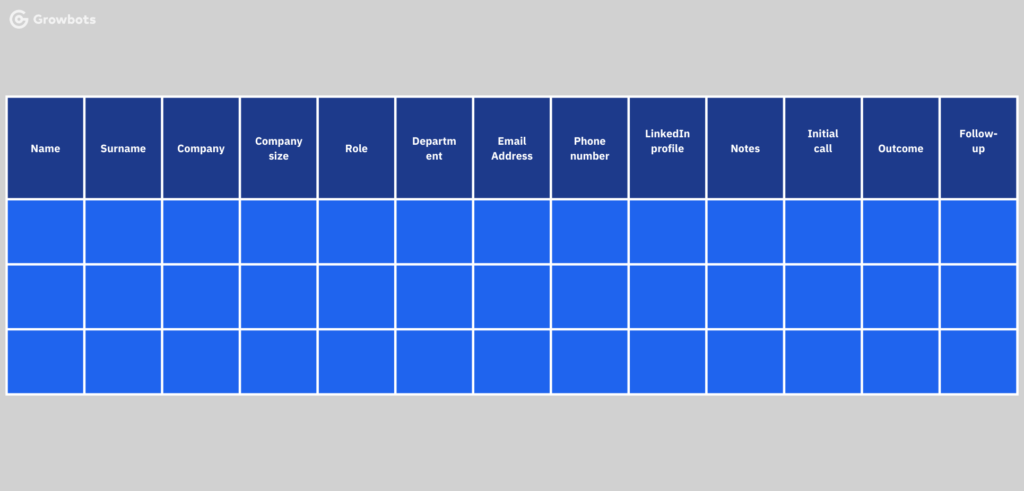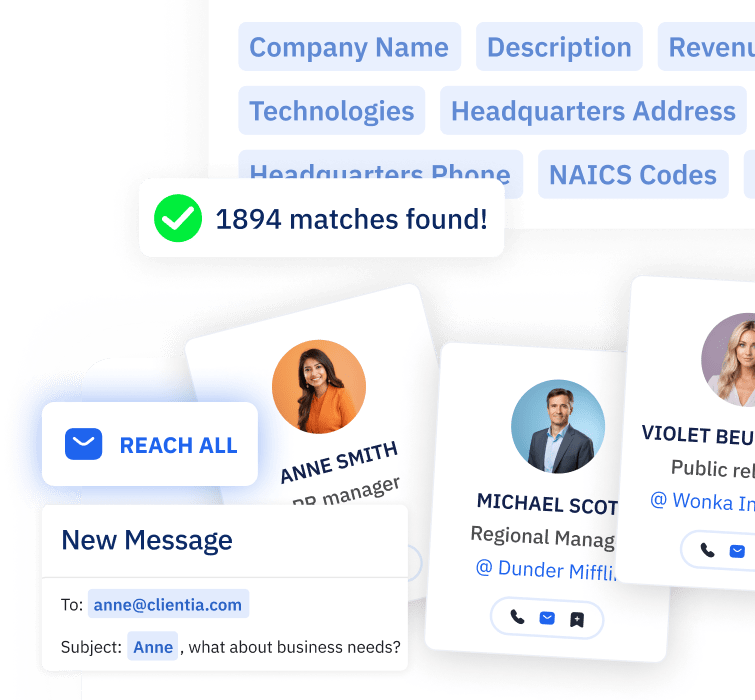Every salesperson knows that the key to their success lies in the quality of leads they generate.
The process of generating a list of qualified prospects is known as prospecting, and it can be a critical part of any successful sales strategy.
In this article, we’ll look at the key considerations and best practices to keep in mind when it comes to building and managing a B2B prospecting list.
What is a Prospect List in Sales?
Prospect lists, often referred to by sales professionals and sales reps as prospecting lists, are curated documents with data of potential customers that a business aims to convert into existing customers.
Lists like that are pivotal tools used to generate leads and streamline the overall sales process within a company. Such a list typically includes contact information to the particular prospect, their company information, and other relevant prospect data that aligns with the company’s buyer persona and ideal customer profile.
The overall goal is to find and qualify leads efficiently, ensuring that both the sales team and marketing team target people that resemble your most valuable customers.
In addition to e.g. cold calls and manual email outreach, most sales teams are now leveraging tools like Growbots to automate outbound sales by streamlining the process of building prospecting lists and scheduling cold outreach campaigns to prospects they have identified.
Why Take the Time to Create a Great Prospect List?
Creating a comprehensive B2B prospecting list takes time and effort, but it’s well worth the investment.
After all, a quality prospect list with verified contact details can help sales representatives to expand their pool of existing customers with more prospects.
Take a look at these key benefits:
1. Improved Lead Qualification
By segmenting your leads and adding pertinent data, you can better identify high-quality prospects and quickly eliminate those who are unlikely to convert.
This saves you time and energy (and, in turn, money) that can be put to better use elsewhere.
2. Refined Messaging
Having a better understanding of your leads gives you an opportunity to create and tailor your messages accordingly.
People love to be addressed personally. By using a well-informed prospect list, you can craft messages that are more likely to resonate with the recipient and, ultimately, result in greater success.
3. Increased Efficiency
A well-sourced prospect list allows sales reps to identify prospects and target them quickly, increasing efficiency in the process. This can help streamline the sales process, saving time and resources that can be put towards other areas of the business.
Now that you know what prospect lists are and why they are important, let’s dive into tips on how to actually build a prospect list and make sure that your prospecting plan is bound to success.
How to Build a Sales Prospecting List
Building a sales prospecting list is an important job, but doesn’t have to be stressful.
It simply comes down to keeping some key considerations and best sales prospecting practices in mind throughout the process.
Doing it right simply comes down to keeping some key considerations and best practices in mind throughout the process.
We’ve done you the favor of compiling the most important in a breakdown below.
leave no lead unexplored
Every potential client within reach
- 180m+ contacts
- CRM integrations
- 23 Prospect filters
- 15 Company filters
Know What You're Selling
Pretty simple, right? Maybe not.
While it seems like a no-brainer, a surprising number of salespeople don’t take the time to understand their offering before embarking on calls or sending cold emails to their potential customers.
While it seems like a no-brainer, a surprising number of salespeople don’t take the time to understand their offering before embarking on calls.
It’s a pivotal step that must be taken before you even start thinking about customers; without knowing the ins and outs of the product, you won’t be able to do your job effectively.
While many sales organizations offer lengthy on-boarding processes, to be truly exceptional, your knowledge of the offering must surpass the basics.
It should dive deeper into specific use cases, features, and success stories. It’s this level of understanding that will help you qualify prospects, close deals, and move the needle.
Not only that, but having a strong grasp of the product will help you anticipate questions, provide knowledgeable answers on calls or in emails, reply confidently, and in the end, achieve your sales goals. No one wants to go into a fire without a fire extinguisher.
The more you know about your product ahead of time, the more equipped you’ll be to engage prospects, close deals, and make a lasting impression.
If you’re unsure of whether your current knowledge stacks up, consider asking yourself these important questions:
- What are the key features of the product?
- How do those features help customers solve their problems?
- Are there any common product misunderstandings or concerns I should be aware of?
- Are there any success stories I can use as examples on calls?
- How could I explain the product to a five year old?
- What type of feedback does this product get?
Answering these questions will go a long way towards helping you build credibility and confidence as a sales rep.
If you can’t come up with anything satisfactory, it’s a sign that you should take the time to do more research.
Know Your Buyer
Although this may also seem obvious, it’s still a pivotal step that must be taken to ensure that leads are qualified and the right prospects are reached.
Knowing who you’re selling to is a key factor in determining the type of content needed, as well as strategizing on how to present it.
Again, many teams already do this in some way, but it doesn’t hurt to invest a little extra time and energy into customer research.
This can be done through various means, such as reading reviews, conducting interviews with past and current customers, researching competitor offerings in the same space, or even browsing online forums.
Take a fresh look at your customers with each new product launch and make sure you have a good understanding of their preferences, needs, and pain points. Existing personas are always a great reference tool, although you should aim to update them regularly.
When creating a sales prospecting list, try to hone in on specific types of customers based on criteria like industry, company size, job title, and revenue.
These simple yet important questions can help you identify qualified leads and target the right prospects for your offering.
Beyond the basics, there are a number of other characteristics to consider, including…
- Pain Points: What challenges does your buyer face?
- Goals: What are their short-term and long-term objectives?
- Decision Makers: Who will be involved in the decision-making process?
- Buying Process: What is the typical customer journey like?
- Success metrics and goals: How will they measure success?
- Likes and dislikes: What type of content resonates with them?
- Past experiences: What have their previous interactions with similar products been like?
- Engagement preferences: What type of content and delivery methods do they prefer?
- Referral potential: How willing are they to refer or recommend your product?
Taking the time to find the relevant prospect information and understand how your customers think and approach purchases can help you build stronger relationships with prospects, as well as craft more effective conversations.
With this information, you can create more targeted campaigns that are better suited to their needs and interests.
Start Looking for Leads
Once you have a good understanding of your product and buyer, the next step is to start your prospecting activities and begin identifying potential leads.
The goal here is to create a list of people and companies that you can reach out to with your offer.
Start by developing a list of criteria for what makes a good lead:
- Does this potential customer match the target demographic for your product?
- Are they currently facing any problems or challenges that your product can solve?
- Are they likely to consider switching from their current provider or solution?
- Do they have the budget and resources necessary to purchase your product?
- Are they in a position to make decisions or influence the buying process?
After you have the overview of what data points your sales prospect list should include, you can start the actual search.
If you have now started wondering how you can find contact details like phone numbers and other sales prospect details, we’re here to give you some more sales tips.
There are two ways you can fuel your sales prospect lists with data: online and offline.
Finding leads online
Getting started with your prospecting efforts on the web is a great idea. There are tons of tools out there that can help you find and research leads, including social media platforms, CRM systems, and lead-generation services.
LinkedIn, for example, can be a great source of leads and different prospect information for your lead generation process. You can use advanced search filters to narrow down prospects in your target market.
During your prospecting activities, you should also look into industry-specific lead databases and resources, as well as online forums where like-minded professionals can be found.
Twitter is another great resource for researching potential leads and finding prospect information. Not only can it help you identify people who may need your product, but it also allows you to get a better sense of their interests and preferences.
That being said, looking for relevant prospects online is a time consuming and sometimes dire task.
This is why it might be a good idea to invest in one of many sales prospecting tools that are available on the market. One example is Growbots which is a sales prospecting tool that will help you automate the prospecting process, provide you with a high-quality contact base, and decrease the overall time you need to spend on trying to increase your client pool.
Finding leads offline
The internet is full of people who are your potential clients but as one of the sales representatives you shouldn’t forget about offline sources, either.
Local events, conferences, and trade shows can be great places to network and spot potential customers that might fuel your sales funnel. A good idea for sales teams is to also reach out to existing customer references.
Why?
Your existing customers may be willing to provide referrals or even introduce you to other potential leads.
No matter how you find your leads, make sure to take the time to properly research each one and record the insights you gather.
This will help ensure that you’re targeting the right prospects and wasting as little time as possible, ensuring the success of your lead generation efforts.
Read also: Best sales books for SaaS businesses you must read
Organize
At this point, you should have two sets of information; one about your product, and the other about your customers.
The next step is to merge the two sets into a well-organized B2B list that will serve as your foundation for successful prospecting.
To do this, you’ll need to start by categorizing each lead into different segments.
For example, if you’re targeting businesses in a specific sector, you’ll want to create a separate segment for each industry. Other segments could include job titles, location, and company size.
Once your leads are organized into categories, you’ll need to create a system for tracking each one. This could include creating custom fields in your CRM or spreadsheet program, assigning a unique number to each lead, or even building a sorting algorithm if you’re feeling ambitious.
The goal here is to have a concise, easily-navigable list that you can reference whenever you need to. This will help you keep track of leads, prioritize your outreach efforts, and make sure that no prospect is ever overlooked.
Prioritize Quality Over Quantity
When building a prospecting list, especially being a part of a sales team, it’s easy to get swept up in the numbers game.
After all, having more potential buyers means more opportunities to close deals, right?
Not necessarily. Quality is always better than quantity; if you’re spending all your time targeting the wrong people, you won’t see a good return on the time and energy you put in.
It is all about common sense in balancing those two things, mostly depending on the company the prospecting is for and how wide its target is.
Start by segmenting your list and identifying leads who are likely to be interested in what you’re offering. You want to focus on building relationships with ideal customers – those who are most likely to convert (and, more importantly, stay loyal after conversion).
As you start to get a better handle on your ideal customer profile, you can then expand your sales prospecting techniques in favor of more reach.
This is also where data enrichment tools come in handy; they can help you enrich your prospect list with pertinent information about your customer profiles, such as job title and company size.
Test and Measure
It’s important to measure the success of your prospecting efforts. The only way to truly understand how successful you are at generating qualified leads is by testing different tactics and tracking the results.
To begin, write down a list of prospecting strategies that you plan to use; some examples could be cold-calling, email campaigns, direct mailers, etc.
Then, track the performance of each tactic in terms of response rate and lead quality. For instance, track the number of calls you made, emails sent, etc., and compare that to the number of generated leads. Remember to review your approach as a whole as well as each individual part.
Strive to go beyond quantifying success with leads alone – it’s entirely possible for a strategy to yield lots of leads that don’t amount to anything.
Consider alternative metrics like the percentage of leads that ended up converting, and how much revenue each lead generated.
Over time, you’ll be able to identify which strategies are working for you or your sales team and which ones aren’t. This knowledge can be used to refine your approach, eliminate waste, and maximize efficiency.
Keep Things Updated
So, you’ve compiled a detailed overview of your product offering and customer segments, segmented your leads into categories, and tracked the performance of different tactics.
Now what?
The job is far from done – remember, your B2B prospecting list is a living document. You’ll need to keep it up-to-date as your business evolves and new leads come in.
This can be accomplished by regularly auditing your list, adding and removing contacts as necessary, and ensuring that all the information is accurate and up to date.
You should also stay on top of the latest trends in your industry. This can help you identify new prospects and hone your messaging to better resonate with customers.
And don’t forget to keep track of the leads that didn’t convert – this can help you understand what went wrong and what you need to do in order to adjust your approach accordingly.
You can also recycle the contact details of contacts that simply didn’t respond to you and reach out to them in a few weeks or months time to see if they are receptive to your outreach then.
Seek, pick, and reach
Connect with your potential customers
- 180m+ contacts
- Advanced filtering
- Multichannel sequences
- CRM integrations
Sales Prospecting List Templates
You now know all the insights about building a prospecting list but what should one look like in real life and what information should be included on such a list?
Usually, sales teams use the following types of templates:
Basic prospecting list templates
There are many templates available online but usually, a basic sales prospecting list includes the following details:

Such a table can be additionally enriched with more details about the contact, like the size of their company, website address, a link to their LinkedIn profile or an information about initial contact or a follow-up:

As you can imagine, filling in such prospecting tables manually takes a lot of time.
This is why using an automated prospecting tool which can speed up this process is a smart investment – instead of spending hours looking for contacts and filling in lists, you can work on defining your sales pitch, reaching out to prospects, and closing the deals.
Building your sales prospecting list with Growbots
Growbots provides you with access to a database with over 160M contacts to decision-makers across the world.
Using both standard criteria (like industry, company size, position) and advanced filters (used website technology, funding etc.) you can easily build a list of companies that match your profile and make high quality sales leads for your business.
Thanks to live email verification, Growbots’ database is updated continuously so you don’t need to worry about the emails you send landing in spam and your mailboxes being blocked. You can read more about email deliverability in one of our previous articles.
The prospecting lists you build with Growbots can be easily exported and imported into your CRM or outreach tool.
However, Growbots offers an outreach tool built right into it that you can use to reach out to the prospected contacts without having to import them to a different tool.
Conclusions
Prospecting is a necessary part of sales and the day-to-day sales team job, but it doesn’t have to be a chore. By keeping these considerations and best practices in mind, you can ensure that your efforts are targeted, efficient, and successful. Good luck!

Maciej Skoczyński
Account Executive Team Leader at Growbots
























